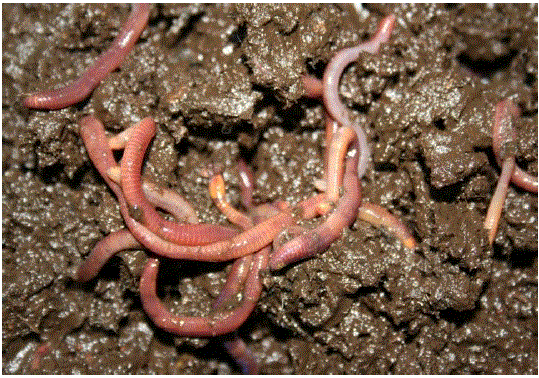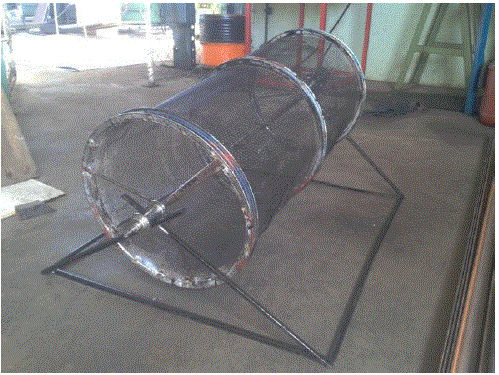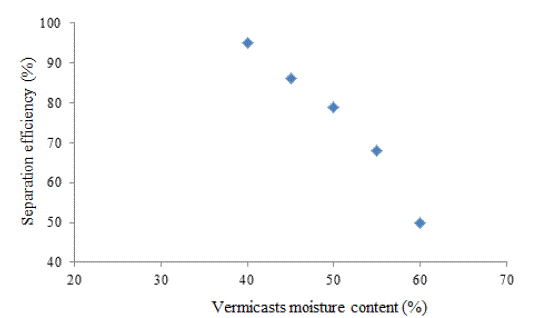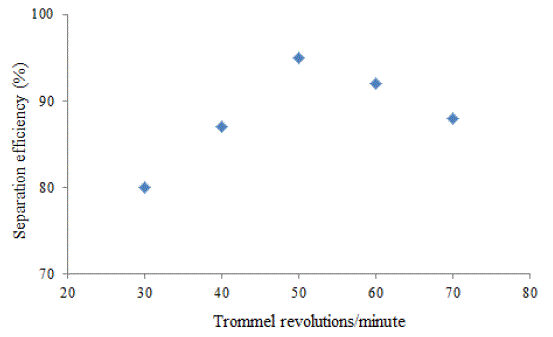ISSN ONLINE(2319-8753)PRINT(2347-6710)
ISSN ONLINE(2319-8753)PRINT(2347-6710)
|
Musaida Mercy Manyuchi1* and Anthony Phiri2 Lecturer, Department of Chemical and Process Systems Engineering, Harare Institute of Technology, P. O. Box BE 277, Belvedere, Harare |
| Related article at Pubmed, Scholar Google |
Visit for more related articles at International Journal of Innovative Research in Science, Engineering and Technology
Vermicomposting technology is widely being used worldwide as a solid waste management strategy. During vermicomposting Eisenia fetida earthworms ingest the solid organic waste and after a bioconversion process it is expelled as vermicasts. These vermicasts can be used as solid bio-fertilizers; however there are challenges of separating the earthworms from the vermicasts after vermicomposting. Pilot studies were therefore done using a cylindrical rotary trommel screen separator prototype to efficiently separate the earthworms from the vermicasts. The vermicasts were obtained from vermicomposting waste corn pulp mixed with cow dung manure and waste office paper. The cylindrical rotary screen had a mesh size of 4 mm, length of 250 mm and diameter of 90 mm. A throughput of 1.3 m3/hr comprising of vermicasts and earthworms with a moisture content of 40-60% was separated trommel screen rotational speeds of 30-70rpm. The vermicasts separation efficient was around 80-95% but optimum separation of 95% was achieved at 40% moisture content and trommel screen rotational speed of 50rpm. Using a mechanical trommel screen separator increased the separation of vermicasts and earthworms, hence making the vermicomposting technology ideal.
Keywords |
| Earthworms’ separation, Eisenia fetida, vermicompost, vermicasts, trommel separator |
INTRODUCTION |
| Vermicomposting technology is widely being used worldwide as an organic solid waste management strategy [1]-[12]. Vermicomposting is the use of earthworms for the bio-conversion of organic waste into vermicasts and vermiwash [1]- [12]. During vermicomposting, earthworms ingest the organic waste which is digested and expelled as granules called vermicasts [1]-[12]. These vermicasts are odourless and dark brown in colour and are in combination with unprocessed bedding and earthworms before separation (See Fig 1). Furthermore, a leachate called vermiwash is also produced during vermicomposting [1]-[12]. Vermicasts and vermiwash are rich in nitrogen, phosphorous and potassium as well as trace elements [1]-[12]. The nutrient composition of the vermi-products creates a potential for them to be used as bio-fertilizers [1]-[12]. Vermicompost vermicasts and vermiwash has been used for organic farming of rice, Indian borage, kharif crops, okra and maize [2],[4]-[5], [6], [8]and [10]. Although, vermicomposting has been widely adopted as a solid waste management strategy, a challenge has been faced in terms of separation of the earthworms from the vermicasts [12]. Harvesting of earthworms from the vermicasts is a time consuming process which can take up to 0.0283m3 of vermicasts per hour [12]. |
 |
| Fig 1: Vermicasts and earthworms obtained from vermicomposting |
II. MATERIALS AND METHODS |
| A. Materials This study was carried out at the Harare Institute of Technology. The vermicompost was obtained from vermicomposting various organic waste including corn pulp, cow dung and office paper [1], [3], [5], [7] and [9]. Eisenia Fetida which is an epigeic earthworm species were used for vermicomposting [1], [3], [5], [7]and [9]. The vermicompost had average particle diameters of 300-500μm, whilst the earthworms had an average weight of 200- 250mg. The 250mm by 90mm rotary trommel screen constituted of 3 bicycle rings, a 4 mm wire mesh and an electrified aluminium bar that cut through the trommel screen. The trommel screen was powered by a 100W electric motor and mounted on carbon steel rods (Fig 2). The vermicasts and earthworms were placed inside the trommel screen at a throughput of 1.14m3/hr. A rotation was introduced, the vermicasts left through the wire mesh whilst the earthworms, unprocessed bedding and cocoons exited at the end of the trommel screen due to rotational motion. The rotary trommel separator is indicated in Fig 2. |
 |
| Fig 2: Earthworm trommel separator |
| B. Methods The efficiency of separation of the trommel separator was determined upon varying the moisture content (40-60%) of the vermicasts as well as the rotational speed of the earthworm trommel separator (30-70 rpm). Moisture content of the vermicasts was measured by heating the vermicasts at 105◦C for 15 minutes, using an AND moisture analyser. Electricity was supplied to the trommel screen and the pedal by direct coupling. The rotational speed of the trommel screen was determined by tying a ball to the bicycle ring on the trommel and counting the times it rotated per minute. The rotating speed was increased by decreasing the distance on the pedal. The separator efficiency was calculated according to Equation 1: |
 |
III. RESULTS AND DISCUSSION |
| A. Vermicasts separation at varying moisture content The earthworm trommel separation efficiency on the vermicasts decreased with increased moisture content of the vermicasts at constant rotational speed of 50 rpm (Fig 3). The optimum separation was achieved at 40% moisture content as the vermicasts; unprocessed bedding and earthworms could easily be separated. Higher moisture content values promoted clumping of the vermicasts; earthworms and unprocessed bedding together hence lower separation efficiency. |
 |
| Fig 3: Vermicasts separation efficiency at varying moisture content and trommel rotation speed of 50 revolutions per minute |
| B. Vermicasts separation at varying trommel rotational speed The earthworm trommel separation efficiency on the vermicasts increased with increased rotational speed at constant moisture content of 40% (Fig 4). The optimum separation was achieved at 50rpm (Fig 4). Lower rotational speed promoted clumping together of the vermicasts hence ineffective separation. At the same time, increased rotational speed of more than 50rpm caused some of the vermicasts to be separated with the earthworms and unprocessed bedding thereby decreasing the separation efficiency. Furthermore, at higher revolutions of more than 50rpm, earthworms indicated distress as they were thrown hard from the earthworm trommel screen. |
 |
| Fig 4: Vermicasts separation efficiency at varying rotational speeds and constant vermicasts moisture of 40% |
IV. CONCLUSION |
| Employing a trommel screen separator efficiently separated earthworms from vermicasts that were produced during vermicomposting. Lower moisture contents of the vermicasts of around 40% and trommel rotational speed of 50 rpm are recommended for optimum earthworm separation. This innovation helps to increase the production capacity in vermicomposting processes making it 97% more effective compared to handpicking of earthworms from the vermicasts per hour. |
ACKNOWLEDGMENT |
| Mr M. Lieto and Mr W. Sibanda are acknowledged for assisting in building the prototype. Harare Institute of Technology is thanked for funding this work. |
References |
|